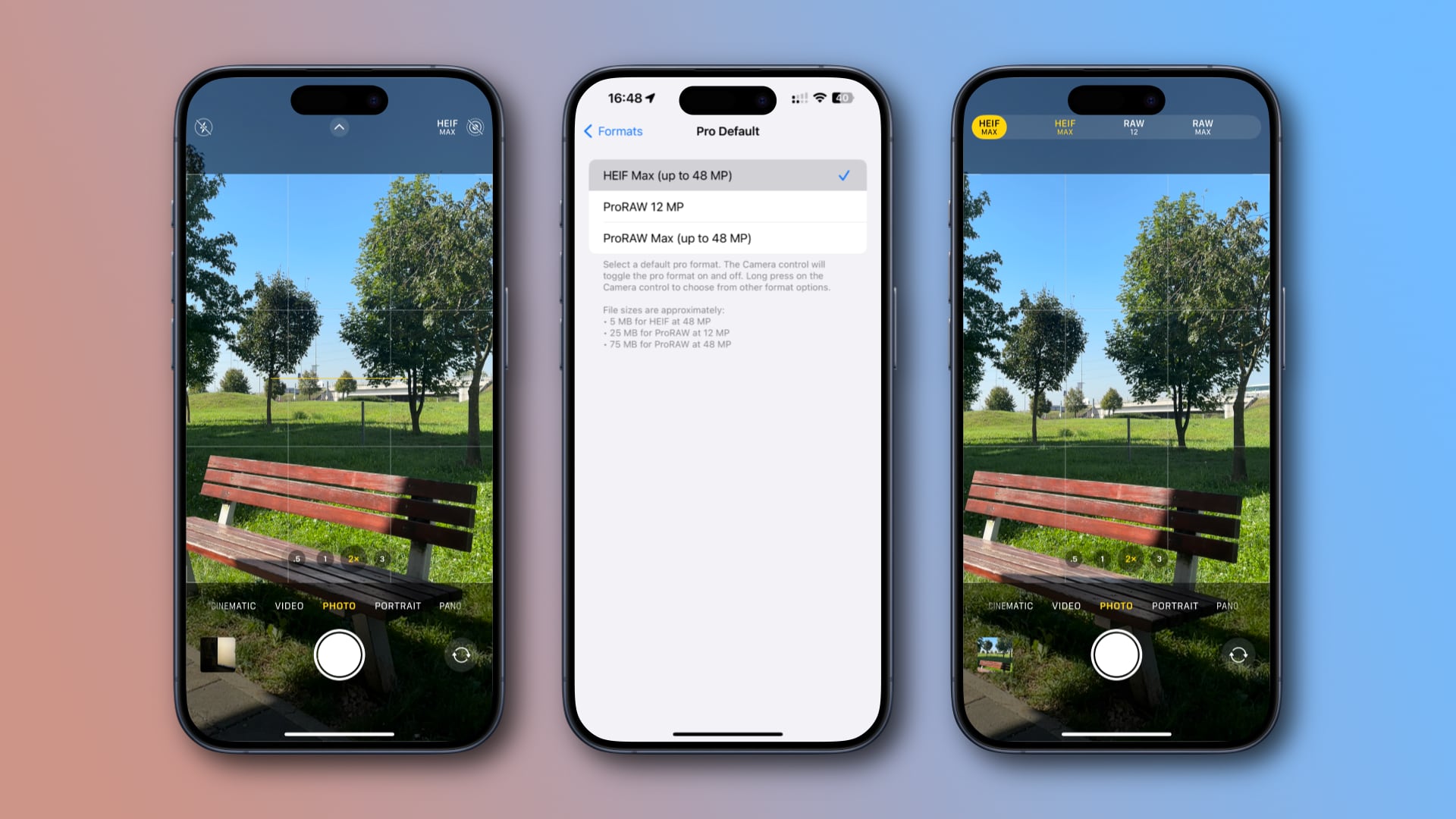Learn how to set your iPhone’s Camera app to capture full 48MP resolution photos in the HEIF or JPEG format instead of 12MP or 24MP ones.

Out of the box, iPhones equipped with a 48MP (megapixel) rear camera sensor are set to snap images in the 24MP or 12MP resolution to simplify sharing and save storage space. However, switching to the full-resolution 48MP capture will result in crisper images (4x more pixels) and give you more creative freedom in terms of cropping and framing.
iPhones with 48MP cameras
The iPhone 14 Pros and all iPhone 15 and iPhone 16 models are equipped with a 48MP camera, compared with a 12MP rear shooter on older models from the iPhone 6s to the standard iPhone 14 and iPhone 14 Plus.

Resolution comparison
Here are image resolutions for 12MP, 24MP, and 48MP captures:
- 12MP: 3024 x 4032
- 24MP: 4284 x 5712
- 48MP: 6048 x 8064
12MP or 48MP?
Shooting 48MP images for sharing on social media and blog posts is an overkill; 12MP strikes the right balance between file size, image quality, and resolution. Stick with 12MP unless you need to print photos on larger formats, preserve fine detail, or zoom deep without pixelation.
How about 24MP?
All models in the iPhone 15 and iPhone 16 lineups are also capable of taking 24MP images, which offer more detail (great for zooming and cropping) while keeping file size manageable. You can set image capture resolution for the built-in Camera app to 12MP or 24MP in Settings > Camera > Formats > Photo Mode.
Take 48MP photos with your iPhone
You need to turn on the Resolution Control option in settings. After that, select HEIF MAX or JPEG MAX at the top of the Camera app interface to take space-saving 48MP pictures in one of these formats.
1) Open the Settings app on your iPhone, tap Camera, and select Formats.
2) Turn on the ProRAW & Resolution Control switch. This setting only appears on iPhone Pros that support ProRAW photography; for non-Pro models, turn on the Resolution Control switch instead.

Be sure to set Camera Capture to either High Efficiency (HEIF) or Most Compatible (JPEG). HEIF is the default shooting format in iOS as it takes less space than JPEG.
3) Launch the built-in Camera app and toggle the HEIF MAX or JPEG MAX button near the top-right corner so it’s no longer crossed out.

If you see the RAW MAX or RAW 12 button instead, touch and hold it to reveal a hidden menu to select the HEIF MAX/JPEG MAX option from there.

Both HEIF MAX and JPEG MAX support 48MP pictures. The RAW MAX setting (available on iPhone Pros) will let you shoot ProRAW images in 48MP (regular RAW 12 is limited to 12MP).
4) Take a photo using the main iPhone camera, and confirm it’s 48MP by opening the image in the Photos app and swiping up or hitting the info button ⓘ.

When iPhone won’t take 48MP images
Night Mode, Live Photo, Telephoto, Wide, Portrait, flash, and macro images are always 12MP, even if you select HEIF/JPEG MAX in the Camera interface. The iPhone 16 Pros also have a 48MP ultra-wide camera for taking much crisper macro photos and ultra-wide shots.

Set your iPhone to take 48MP images
The Camera app doesn’t remember the selected image resolution and format upon closing. To make it preserve the selected capture format, go to Settings > Camera > Preserve Settings and turn on the switch for ProRAW & Resolution Control or Resolution Control.

iPhone Pro owners can also choose between HEIF MAX and JPEG MAX as their default shooting format in Settings > Camera > Formats > Pro Default. To override this setting and take RAW photos instead, just touch and hold the HEIF MAX or JPEG MAX button in the Camera app and select either RAW MAX or RAW 12.
- HEIF MAX/JPEG MAX: Capture photos in the space-saving HEIF format or the ubiquitous JPEG format.
- ProRAW 12 MP: Shoot and encode 12MP images using the Apple ProRAW format.
- ProRAW Max: Shoot full-resolution 48MP images in the ProRAW format.
File sizes: JPEG vs. HEIF vs. ProRAW
JPEG and HEIF use lossy compression techniques which discard some information to keep file size down, which may results in visible compression artifacts. JPEG is supported everywhere while HEIF gives you the same quality as JPEG but in fifty percent smaller files. ProRAW uses lossless compression to keep all details and a range of information captured by the images sensor, which results in large file sizes.
- 5 megabytes for HEIF at 48 megapixels
- 10 megabytes for JPEG at 48 megapixels
- 25 megabytes for ProRAW at 12 megapixels
- 75 megabytes for ProRAW at 48 megapixels
ProRAW or HEIF/JPEG?
Use ProRAW if you need additional control over exposure, color, and white balance without Apple’s computational photography algorithm being too aggressive. Otherwise, stick to the storage-friendly HEIF or JPEG. You can open and edit ProRAW images in the stock Photos app and compatible third-party apps that support the digital negative (DNG) format, like Pixelmator, Photoshop and others.
Choose your camera format carefully
Knowing when to select which format is a vital photography skill. The vast majority of iPhone owners will want to stick to HEIF or JPEG. ProRAW only makes sense if you’re an iPhone photographer who wants to take images without Apple’s algorithm messing with the exposure, color, and white balance because all image processing is burned-in when using HEIFF or JPEG.